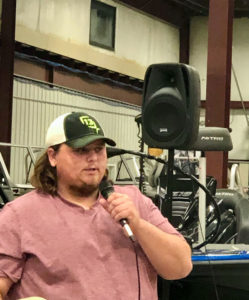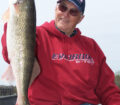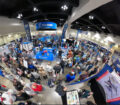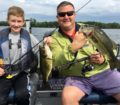By Steve Weisman

(photo by Steve Weisman) Seasonal DNR employee Dominick Foley shares research information compiled by Research Biologist Jonathon Meerbeek and his Natural Lakes Research team at the Spirit Lake Hatchery.
The recent Iowa Great Lakes Fishing Club’s fall “DNR Night” held on Thursday, November 14 drew one of the largest crowds I can remember. Held at the Oak Hill Outdoor facility located at the corner of HWY 71/86 across from Perkins Restaurant, I’d estimate close to 200 people were in attendance. What I appreciated the most (plus the free pizza and exchanging good fishing tales) is the chance to listen to a yearly update from DNR personnel.
Clay/O’Brien County Conservation officer Joe Yarkosky, of course, shared law enforcement updates along with some of the unique cases involved. At the same time, Yarkosky talked about the heavy rainfall events affected so many Iowans. One of the hardest hit parts of the state was southwest Iowa. Yarkosky noted that all with all of the volunteers, 34 conservation officers from around the state responded to help with evacuation issues. The officers worked in two-officer teams in several communities impacted by the flooding, rescuing 31 people, 17 dogs, 9 cats and 1 iguana-yes, an iguana! At the same time, flooding kept DNR personnel busy dealing with shoreline problems and keeping debris from obstructing flow as water flowed in and out of water bodies.
As DNR Fisheries Biologist Mike Hawkins discussed the status of our area lakes and rivers, he shared an update on the issue of walleyes and muskies leaving the Iowa Great Lakes going out the Lower Gar overflow. This has actually become a fairly common occurrence when there are high water issues with water leaving the lakes and flowing below into Mill Creek. Several times DNR personnel have taken boats below the overflow and captured walleyes and muskies that had gone over the overflow and returned them to the lakes. Altogether, 97 muskies have been captured and returned back to the Iowa Great Lakes, along with 18 walleyes. Sure enough, some of these fish have been captured more than once.
To help with this situation, a new fish barrier and muskie escapement electrode has been installed upstream and activated on October 2 to help stop this migration. According to Hawkins, with this in place, they will begin “fine tuning” the electric field to deter fish-out migration. It won’t have the strength of the barrier that stops fish from coming upstream (bighead, silver carp) into the Iowa Great Lakes chain. The goal is to have it just enough, so the walleyes and muskies feel the current and choose not to head downstream. The Iowa Great Lakes Fishing Club (IGLFC) partnered with the Iowa DNR, providing $2,000 toward this project.
Research is extremely important for the health of Iowa’s fisheries. Extensive research was conducted over the past year spearheaded by Research Biologist Jonathon Meerbeek and his Natural Lakes Research team at the Spirit Lake Hatchery. Seasonal employee Dominick Foley shared the following data:
- both adult and just-stocked muskies with 14 tagged and monitored
- 4,930 walleyes sampled during gillnetting
- yellow bass populations in 15 natural lakes to determine diet and overlap with native species, evidence of stunting and mortality
- carp and buffalo densities in eight area lakes monitoring changes in fish populations and habitat
- spring electrofishing at 16 natural lakes: Black Hawk, Center, Clear, Cornelia, East Okoboji, Elk, Five Island, Little Spirit, Little Wall, Lost Island, Lower Gar, Rice, Silver (Dickinson), Silver (Worth), Big Spirit, West Okoboji.
- 2019 surveys on Dog Creek, Douma Pond, Iowa Great Lakes, Ingham Lake, Lake Pahoja, LeMars City Pond, Little Sioux River, Lost Island, Mill Creek Lake, Ocheyedan Pit, Pickerel Run, Silver Lake (Dickinson), Trumbull Lake, West Swan Lake, Willow Creek



















